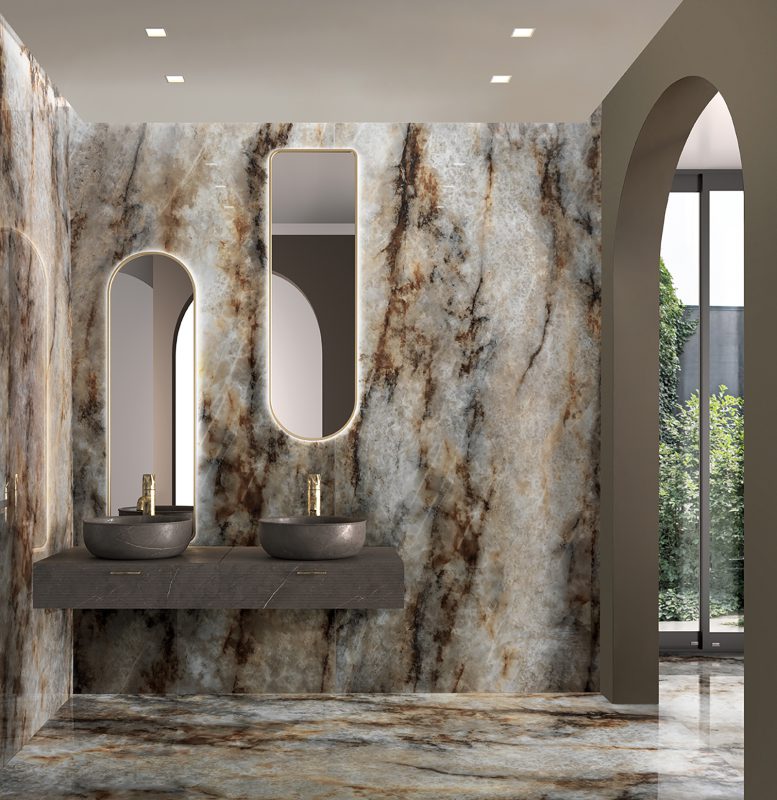Tile Selection
Why Natural Stone Thin Porcelain Panel Tile Replicas Are A Better Option?
Welcome to the Tile Confidential podcast. My name is Sol, an author, tile installer, and owner of Vela Tile Store. I want to help you with choosing tile for your next home improvement project a breeze. You’re about to embark on journey into the world of tile and learn about tile from myself and other leading experts in the industry. The goal is to hep you shop for tile with confidence. This is a community where we share pictures, ideas and everything else to do with tile.
Natural Stone Effect On Porcelain Tiles
What we’re going to talk about today is the relationship between the current trends in thin porcelain slab tiles and natural stone.
All right, so let’s get into it with discussing what is natural stone. We have to make a distinction here because there’s a lot of engineered products that have come out and people think that that’s natural stone, but technically it’s not. So a natural stone is stones that have been harvested in two positions within the Earth, and then they are cut machined into final products. So they typically cut into slabs and then go through more processing if they’re going to be cut into, let’s say, particular sizes for tile or if it’s going to be used as countertops or whatnot. But it starts at the point of harvesting from the earth.
Engineer products are processed basically from like smart particles, and then they’re reconstituted with some kind of a cement base or resin based binders.
And as a result, as you can see, they don’t meet the definition of natural stone because they’re more man made stones.
And when we think about what makes natural stones so appealing is, I think, to do with the fact that it is the fact that it has a bit of a rarity quality about it. And anything that is rare is going to just have more value. It’s going to be more unique because it’s being harvested. Chances are that particular block or slab that you might purchase is not going to be replicated easily by somebody else. It’s coming from a certain spot on the earth, it’s cut in a certain way.
These are all qualities about that particular stone that’s going to be very unique. So it really brings the value of this product up quite a lot, which makes it, or traditionally has made it quite pricey. And if we’re going to think about, let’s say, natural stone tiles, they’ve typically been reserved for people who can afford them because, for instance, marble tiles or travertine tiles has typically been quite expensive with respect to ceramic or porcelain tiles. But that’s going to be changing. And it’s starting to change actually quite a bit with the introduction of thin porcelain panels, or sometimes gauged porcelain panels, they call them, that has been around quite a number of years in Europe, and it’s coming down now in North America.
More and more, more suppliers are importing them in. More stores are carrying them as well, which interestingly, you would think natural stone would still have its status among all the other products. But this kind of replica, you want to say is taking the world by storm. And slabs of tiles that are manufactured are becoming more and more pricey because of the processing that it goes through. And so I’m going to go into the next step of discussing sort of a case for why porcelain tile is probably going to surpass in terms of its value, the natural stone for at least for the next few years.
And you look at, for instance, one aspect of it that everybody might look at is price. So let’s look at typical prices for different types of natural stone tiles. Tran, for instance, can go up to about $15 per square foot. Marble, depending on the marble, would be anywhere between ten to $20 per square foot. These are USD dollars, the stats I picked up over the internet.
And like, for instance, late can you be anywhere between $15 to $28 per square for these slate tiles? And I’m discussing these are quality products. Obviously there’s less quality ones out there as well. It would be cheaper. But let’s just focus on now, gauge porcelain panel can range anywhere between thirty dollars to forty dollars for a very good quality, let’s say European made.
And that’s a lot to do with the cost of importing them, storing them, transporting them. And even though it’s a manufactured product, it’s still quite expensive and up there with the natural stones. So if we think about what makes a lot of things that are unique in our society sought after for by people, it’s an element of status, really, and element of saying, hey, I can afford this. Just kind of putting it out there and letting people know that, hey, look, this is something that it’s the same psychology you want to say with regards to purchasing expensive vehicles or expensive houses or buying an overpriced cottage in Muskoka, which is we’ve seen a lot of during Covid time. But in that case, that’s where it becomes the price of it.It’s really up there with natural stone, if not higher.
The other thing about it is that, for instance, natural stones, as I mentioned earlier, are all unique. So if you see a particular slab and you really like it, chances are of you getting or some, let’s say somebody purchased it, you don’t get your hands on it, chances are you finding the exact same one that you really liked is very tough. But that’s not the case with porcelain. You can see a porcelain tile somewhere and be like, I want that because it’s man made, it’s mass produced, you’re going to get it. You want it, you got it.
So that’s another kind of a gold star for porcelain, is that if you see something online and you really like it, you can get it if you want it. The other thing about natural stone that’s not so much the case with porcelain is that the properties, even within the type of stone that you’re selecting, let’s say marble. The properties even within that type of stone can vary from marble to marble. So as a result, it’s application can be quite limiting in some situations. Whereas that’s not the case with porcelain.
In most porcelain tiles, if they’re categorized a porcelain, they’re going to have a water absorption of less than zero point 55%. So they can be used in showers. Porcelain tiles are quite dense, they’re impervious. And as a result, they can be installed on floors, on walls, outdoors. There are some factors that one needs to take consideration when it comes to like slip resistance and all that kind of stuff.
But it’s not that you need to worry so much as much as you would have to with natural stone. You need to be quite educated about the subject to know that maybe this marble can be used in this particular application. But maybe this marble cannot be just talking about marble. For instance, marble can categorize based on something called soundness and it goes from ABCD. And A soundness marble will be quite more dense than, for instance, D soundness, marble and its applications can be quite limiting for something like a D.
So that’s one other aspect of what makes porcelain tile beneficial.
The other thing is that because natural stone again comes from the earth, it’s going to be really sensitive to things like lighting and the surrounding materials. So as opposed to, for instance, a porcelain tile, whereas going to be pretty uniform across its surface in terms of how it’s going to respond to lighting. So if you are taking a particular stone, you might see it within, let’s say, a showroom. It may look completely different when you bring it home, when you put it up. This can happen with porcelain, but it’s so much less likely.
Another benefit is that what you see in a showroom when you bring home is going to be much more less of a surprise to you, you want to say, than it is with natural stone. And this is an important case too. Let’s say you’re doing a complete renovation and you don’t know what lighting, you don’t know what lumens and all that kind of stuff is going to be for the lighting you’re going to get. But you’ve already picked your flooring and the flooring is maybe some of that stuff you’re going to pick at the end of your renovation process or finalize it. And so these are all the things can affect the lightning of the room, the paint color.
All these things can quite substantially affect the color of which you might see.
An element of maintenance, goes without saying, is definitely one to consider. When it comes to natural stones, one of the things that we look at is the porosity, which basically determines its resistance to decay, resistance to absorption of water.
But that’s not so much the case. You can have a porcelain tile that looks very close to travertine, but it will never have all the problems of porosity that travertine has. And some places they fill them with resin, some places fill it with like a cement based product to kind of fill those holes in travertine. But you won’t have to worry about that with porcelain tiles. The other element to really consider is the abrasion resistance.
So porcelain tiles, they can vary in their abrasion resistance, but they tend to be pretty resistant to scratches, a good one, especially coming from good manufacturers. But that’s not the case with the natural stones. So how we do that is something called the Mohs scale, the Moss scale. I discussed this in the first podcast episode if you want to go back and get a better idea of more description on it. But you can think of it like this, like a soap stone, which we’ll get into discussing has the lowest hardness of all the natural stones.
I mean, it’s so soft and so if you like that look, but you want to put that in your bathroom, porcelain tile can allow you to have that that soapstone look anywhere you want without the worry of scratches.
Marble in itself is sits between three and four. Just to give you an idea. This scale goes from one to ten and determines the density of the different material. And it’s usually used as a test.
You can also compare to other products that you might think of when you’re determining hardness of something. So on the scale, marble can get scratched by a penny, the hardness of a penny. So that’s how sensitive marble can be. So think about like this. Now you want to have a foyer and you know there’s going to be a lot of traffic there.
You like the marble veining. You can either go with marble or you can go with nice porcelain slab or you can go with a panel and you can have none of that problem of scratches. You can run a penny on that porce and tell us which is you want. Nothing’s going to happen. So that’s the other benefit of porce and tails.
So I hope I have kind of given at least a decent enough case on why porcelain tiles are going to be a better choice for most people as we go into the next, I’d say five to ten years in terms of design because of all these qualities that I’ve mentioned. And it still includes the element of status when it comes to having portion to us because although it doesn’t meet maybe like the fact that natural stones are very unique, so you’re going to have the uniqueness element of it. We’re moving into gauge porcelain panels. That’s also going to be a factors of status in there as well. And you can have all those natural stone effects like onyx or marble or travertine or basalt and all that kind of stuff as well.
Want To Listen To The Entire Episode?…
Link To The Full Podcast On Spotify:
https://spotifyanchor-web.app.link/e/SdDjIOJ2Esb
Link To The Full Podcast On Youtube
Channel:https://www.youtube.com/channel/UCF_Bn7bT4FiRG4r5fPFiwIg
Link To My Book:
CANADA https://amzn.to/3wiLlFY
USA: https://amzn.to/3wiok6a
Joint Our Facebook Group And Don’t Miss New Content!
https://www.facebook.com/groups/2583263741816882


